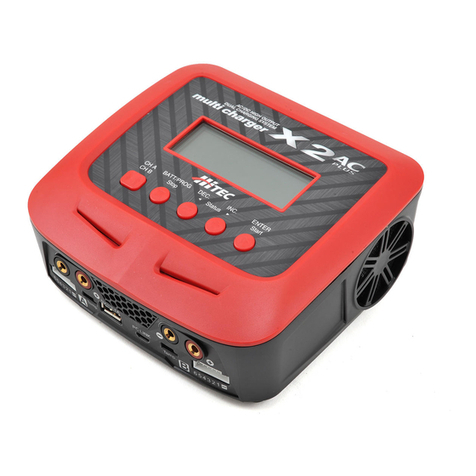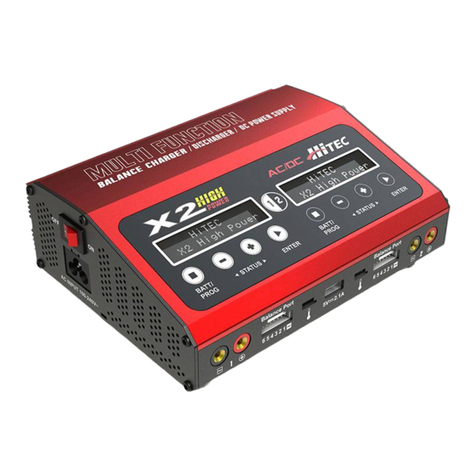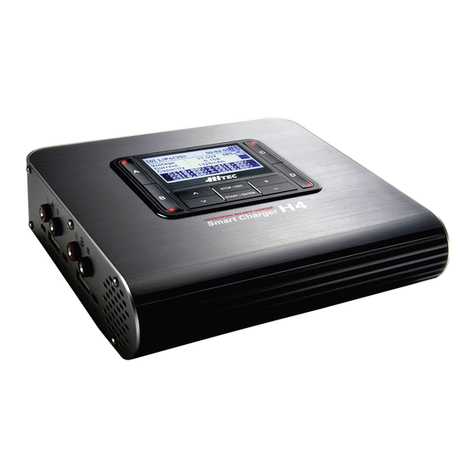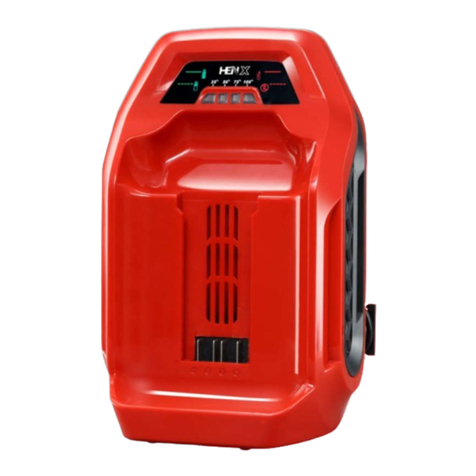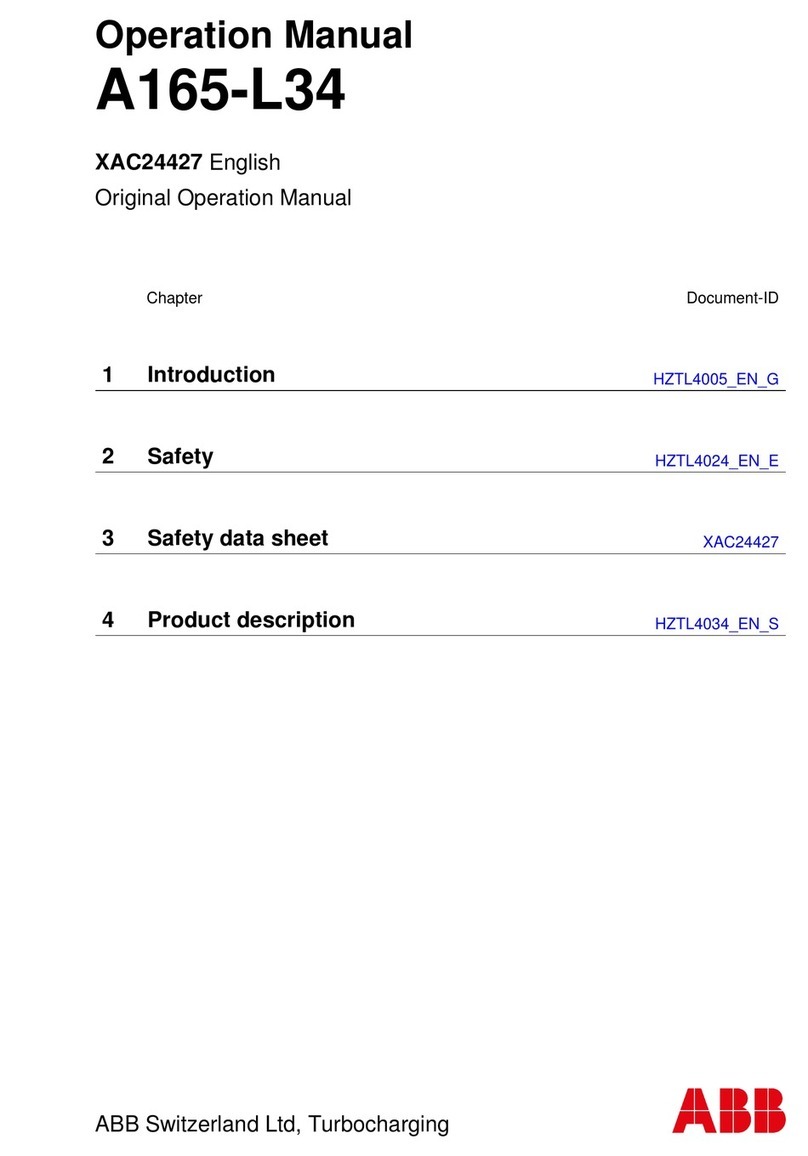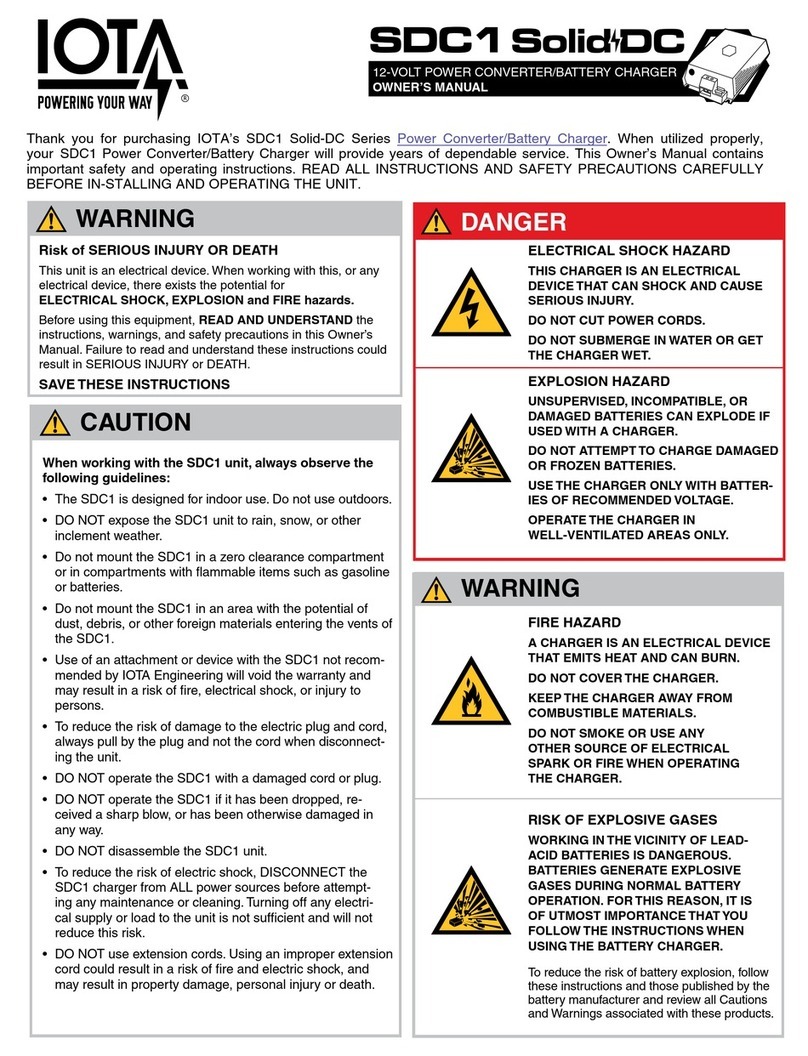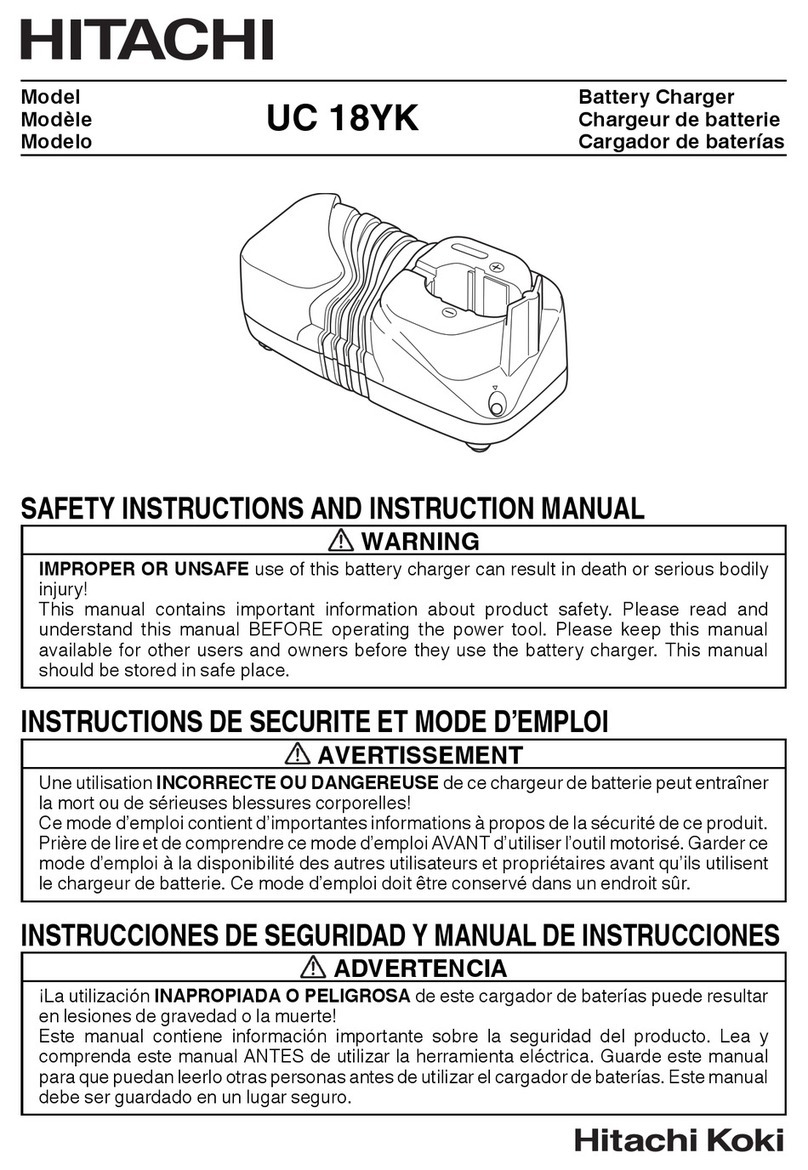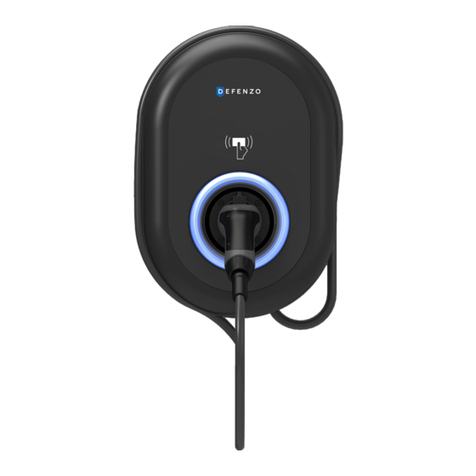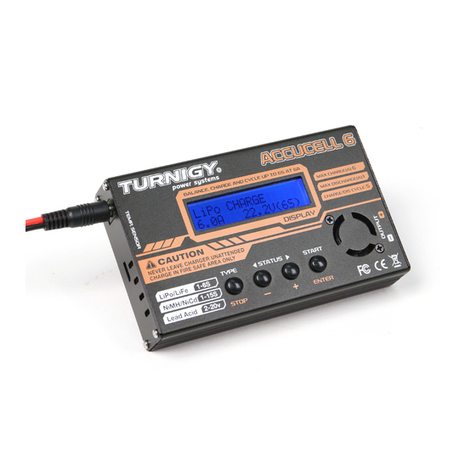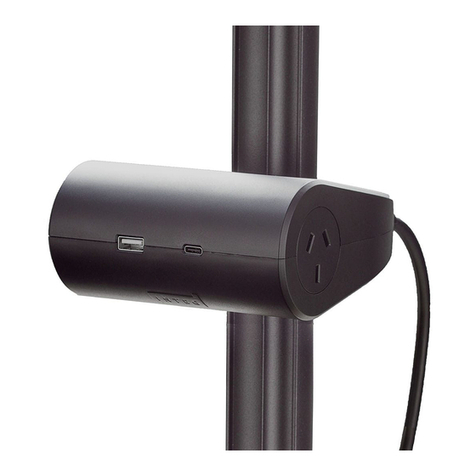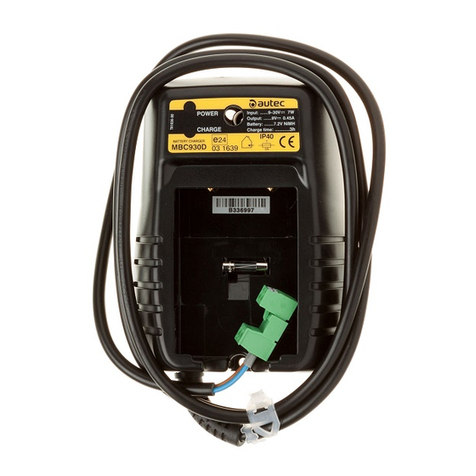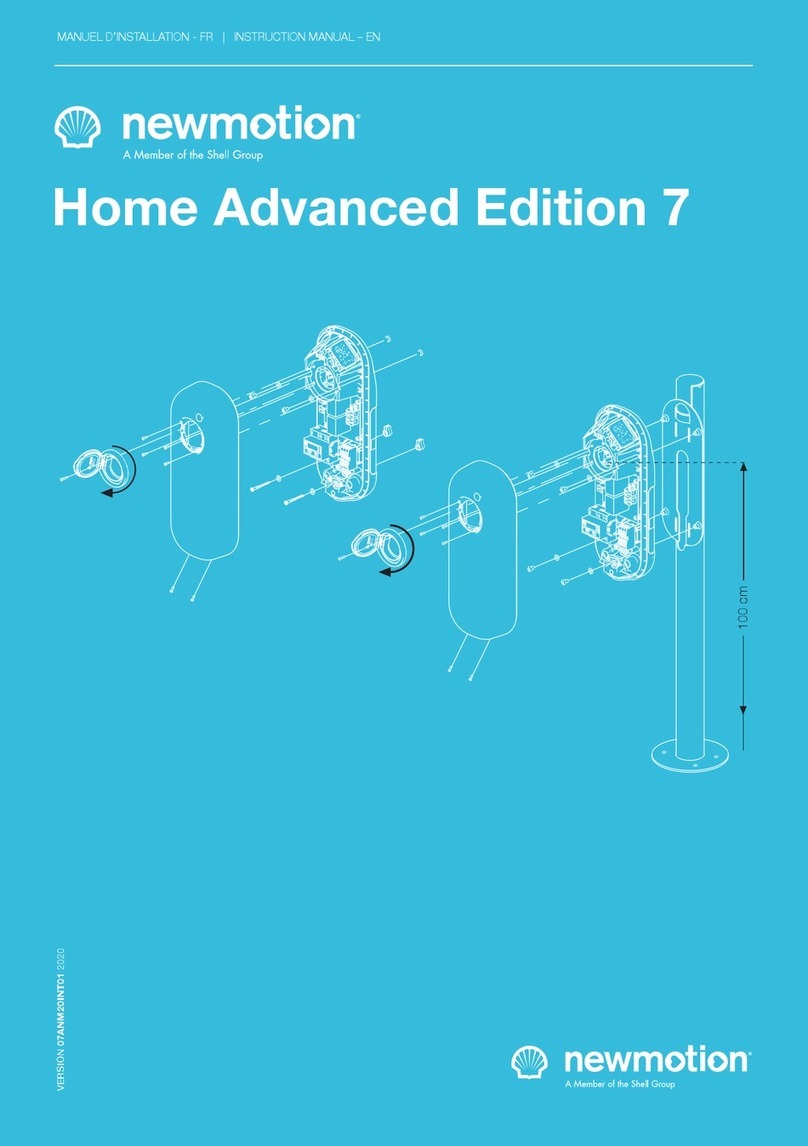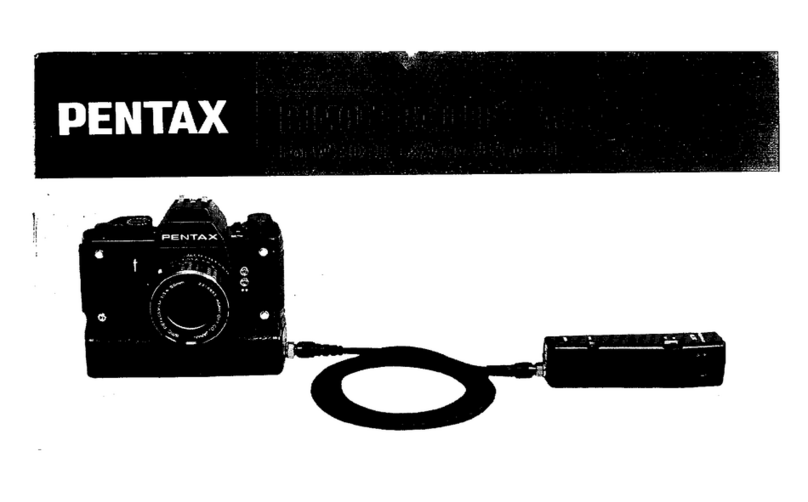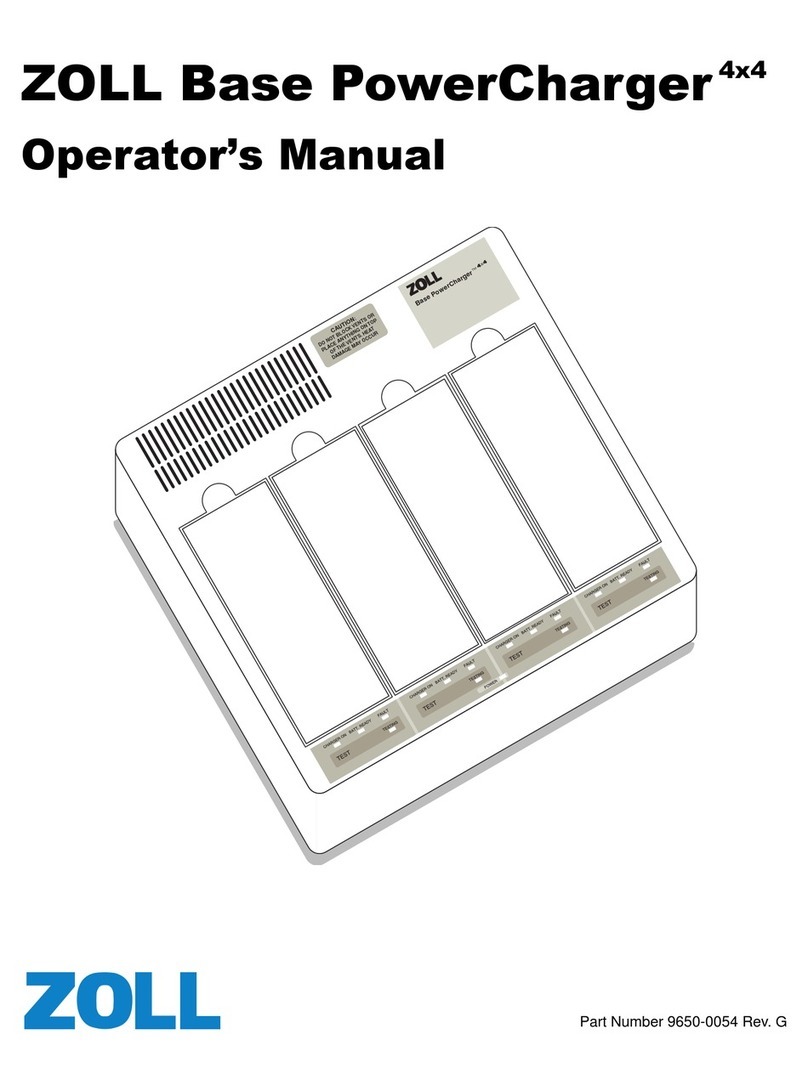Hi-Tec X2 ACPro User manual

OPERATION MANUAL
WARNING: THE CHARGING AND DISCHARGING OF RC HOBBY BATTERIES CAN BE DANGEROUS.
FAILURE TO FOLLOW THE INSTRUCTIONS AND WARNINGS IN THIS MANUAL MAY RESULT IN
PROPERTY DAMAGE AND/OR LOSS OF LIFE.

2
Table of Contents:
Introduction..................................................................................................................................03
Warning and Safety Notes.....................................................................................................04
Product Layout............................................................................................................................08
Specications................................................................................................................................09
Features..........................................................................................................................................10
Battery & Power Supply Connections..............................................................................12
Power Distribution....................................................................................................................13
Operation.......................................................................................................................................14
Program Flow Chart..................................................................................................................15
Charger Operation....................................................................................................................16
Lithium Battery Program [LiP0/LiHV/LiFe/Lilon]..................................................................17
NiMH/NiCd Battery Program.................................................................................................25
Pb Lead-Acid Battery Program............................................................................................29
Battery Meter...............................................................................................................................32
Battery Resistance Meter........................................................................................................33
Soldering Iron..............................................................................................................................34
Memory Preset - Data Store/Load......................................................................................36
Advanced System Set Up........................................................................................................38
Warning and Error Messages................................................................................................40
Using the Charge Control Software [CHARGE MASTER]...................................................41
Recommended Accessory.......................................................................................................41
Commonly Used Terms............................................................................................................42
Conformity Declarations........................................................................................................43
Disposal and Prop 65 Warning............................................................................................44
Warranty and Service...............................................................................................................44
Table of Contents

3
Congratulations on purchasing your new X2 AC Pro Charger! This latest addition
to our innovative charger line oers expanded capacity and compatibility in
a portable and compact package. With dual inputs aording exible battery
charging at home and in the eld, the X2 AC Pro also boasts Hitec’s innovative
power distribution mode which allows you to eciently assign output power
based on individual battery requirements. Capable of charging all battery
chemistries (including the new generation LiHV), this powerhouse has a built-
in 10-amp power supply, internal balancing circuits and 10 dierent charge/
discharge proles. In addition, you may utilize your smartphone for remote
control via our optional WiFi module.
As with all Hitec products, please read the OPERATING INSTRUCTIONS, WARNING
and SAFETY NOTES in their entirety before you attempt to use your new product.
THE CHARGING AND DISCHARGING OF RC HOBBY BATTERIES CAN BE
DANGEROUS. FAILURE TO FOLLOW THESE EXPLICIT WARNINGS CAN
RESULT IN PROPERTY DAMAGE AND/OR LOSS OF LIFE.
ANEVER LEAVE YOUR CHARGER UNATTENDED WHILE IN OPERATION.
ANEVER CHARGE ON OR AROUND COMBUSTIBLE MATERIALS.
ANEVER CHARGE A DAMAGED BATTERY PACK.
ALOW COST, NO-NAME BATTERY PACKS POSE THE MOST DANGER. WE
RECOMMEND YOU ONLY USE BATTERY PACKS THAT ARE SOLD AND
WARRANTIED BY A REPUTABLE COMPANY.
AIT IS HIGHLY RECOMMENDED THAT YOU UTILIZE A SAFETY DEVICE SUCH
AS A STEEL CASE OR LiPo SACK™ WHILE CHARGING LITHIUM CHEMISTRY
BATTERIES.
AIT IS HIGHLY RECOMMENDED THAT YOU KEEP AN OPERABLE “CLASS A” FIRE
EXTINGUISHER IN THE CHARGING AREA.
FAILURE TO FOLLOW THESE WARNINGS CAN BE CONSIDERED
NEGLIGENCE BY THE OPERATOR AND MAY NEGATE ANY CLAIMS
FOR DAMAGES INCURRED.
Hitec RCD USA will not be held responsible for any damages or injuries that may
occur by persons who fail to follow these warnings or who fail to properly follow
the instructions in this manual.
Warning
Introduction
Warning

4
These warnings and safety notes are of the utmost importance. You must follow
these instructions for maximum safety. Failure to do so can damage the charger
and the battery and in the worst cases, may cause a re.
NEVER LEAVE THE CHARGER UNATTENDED WHILE IT IS CONNECTED TO
ITS POWER SOURCE. IF ANY MALFUNCTION IS FOUND, TERMINATE THE
PROCESS AT ONCE AND REFER TO THE OPERATION MANUAL.
AThe allowable DC input voltage is 11-20V DC.
AThe allowable AC input voltage is 100-240V AC.
AKeep the charger away from dust, damp, rain, heat, direct sunlight and
excessive vibration.
AIf the charger is dropped or suers any type of impact, it should be inspected
by an authorized service station before using it again.
AThis charger and the battery should be put on a heat-resistant, non-
ammable and non-conductive surface.
ANever place a charger on a car seat, carpet or similar surface. Keep all
ammable volatile materials away from the operating area.
AMake sure you know the specications of the battery to be charged or
discharged to ensure it meets the requirements of this charger. If the
program is set up incorrectly, the battery and charger can be damaged.
AFire or explosion can occur due to overcharging.
ATo avoid a short circuit between the charge lead, always connect the charge
cable to the charger rst, then connect the battery. Reverse the sequence
when disconnecting.
Warning
Warning: Be sure to read this section for your own safety.
Caution: Be sure to read this section to prevent accidents
and damage to your charger.
Tip: This section will help you maximize the performance of
your charger.
Note: This section will provide more detailed explanations.
Caution
TipWarning
Note
Warning and Safety Notes

5
ANever attempt to charge or discharge the following types of batteries:
• A battery tted with an integral charge circuit or a protection circuit
• A battery pack which consists of dierent types of cells (including
dierent manufacturer’s cells)
• A battery that is already fully charged or just slightly discharged and
non-rechargeable batteries (these pose an explosion hazard)
• A faulty or damaged battery
• Batteries installed in a device or which are electrically linked to other
components
• Batteries that are not expressly stated by the manufacturer to be
suitable for the currents the charger delivers during the charge process
PLEASE BEAR IN MIND THE FOLLOWING POINTS BEFORE YOU
COMMENCE CHARGING:
• Did you select the appropriate program suitable for the type of battery you
are charging?
• Did you set up the adequate current for charging or discharging?
• Have you checked the battery voltage? Lithium battery packs can be wired
in parallel and in series, i.e. a 2-cell pack can be 3.7V (in parallel) or 7.4V (in
series).
• Have you checked that all connections are rm and secure?
• Make sure there are no intermittent contacts at any point in the circuit.
Warning and Safety Notes [cont.]

6
LiPo LiPo HV LiIon LiFe NiCd NiMH Pb
Nominal
Voltage
3.7V/cell 3.8V/cell 3.6V/cell 3.3V/cell 1.2V/cell 1.2V/cell 2.0V/cell
Max. Charge
Voltage
4.2V/cell 4.35V/cell 4.1V/cell 3.6V/cell 1.5V/cell 1.5V/cell 2.46V/cell
Storage
Voltage
3.8V/cell 3.85V/cell 3.7V/cell 3.3V/cell n/a n/a n/a
Allowable Fast
Charge
≤ 1C ≤ 1C ≤ 1C ≤ 4C ≤ 1-2C ≤ 1-2C ≤ .04C
Min. Discharge
Voltage
3.0-3.3V/cell 3.1-3.4V/cell 2.9-3.2V/cell 2.6-2.9V/cell .85-1V/cell .9-1V/cell 1.8V/cell
Standard Battery Parameters
WHEN ADJUSTING YOUR X2 AC PRO CHARGING PARAMETERS, BE SURE
YOU SELECT THE PROPER BATTERY TYPE AND CELL VOLTAGE FOR THE TYPE
OF CELL YOU ARE CHARGING. CHARGING BATTERIES WITH THE WRONG
SETTINGS MAY CAUSE THE CELLS TO BURST, CATCH FIRE OR EXPLODE.
Charging
Before charging your batteries, it is critical that you determine the maximum
allowable charge rate for your batteries. The X2 AC Pro is capable of charging
at high rates that may not be suitable or safe for your particular batteries. For
example, Lithium cells are typically safe to charge at 1C, or the total mAh÷1000.
A 1200mAh battery would have a 1C charge rate of 1.2 amps. A 4200mAh
battery would have a 1C charge rate of 4.2 amps. Some manufacturers are
oering Lithium cells that can be charged at greater than 1C but this should
ALWAYS be veried before charging a Lithium battery at rates higher than 1C.
Voltage is just as critical as the charging amperage rate and this is determined
by the number of cells in series, or “S”. For example, a 3S LiPo is rated at 11.1 volts
(“S”multiplied by a single LiPo cell with a nominal voltage of 3.7 volts DC. 3 cells
x 3.7 volts each equals 11.1 volts DC).
Connect the battery’s main leads to the charger output: red is positive and
black is negative. Keep in mind that the gauge or thickness of your charging
leads from the X2 AC Pro to your battery must be of an acceptable current
rating to handle the applied charge current. For maximum safety and charging
eectiveness, always match or exceed the main battery lead rating when
assembling or selecting your charging leads. If you charge a battery at a high
current rate (amperage) with a charging lead not rated for the chosen amperage,
the wire could get hot, catch re, short out and/or potentially destroy your
battery and the charger.
Warning
Warning and Safety Notes [cont.]

7
When in doubt, always use a higher gauge wire (lower AWG number). It is
common to see charging leads constructed of 14AWG, 16AWG or 18AWG wire.
Always refer to recommendations from your battery manufacturer for your
specic battery type and size before initiating a charge or discharge process.
Do not attempt to disassemble or modify Lithium or Lead-Acid battery packs.
Discharging
The X2 AC Pro discharging functions are for two specic purposes:
• Refreshing the capacity of a Nickel-based battery that has lost capacity over
time (NiMH or NiCd).
• Reducing the voltage of a Lithium battery for safe storage.
LITHIUM CHEMISTRY BATTERY PACKS SHOULD ONLY BE DISCHARGED
TO THEIR MINIMUM SAFE VOLTAGE, NO LOWER. DEEP DISCHARGING
A LITHIUM CELL WILL DO PERMANENT DAMAGE. REFER TO THE
STANDARD BATTERY PARAMETERS TABLE ON PAGE 6 OF THIS MANUAL
FOR MINIMUM DISCHARGE VOLTAGES.
LiPo & LiHV Charge/Discharge Cycling
Lithium batteries are known to reach full capacity after a break-in period of
about 10 charge/discharge cycles. We do not recommend you use the X2 AC
Pro charger to do this; normal use and recharging will achieve the same results.
If you wish to perform a Lithium break-in on the bench with the X2 AC Pro,
discharging to minimum acceptable voltages and performing a balance charge
at 1C maximum rate is recommended. If you choose to break in your Lithium
batteries under normal use, charging at only 1C for the rst ten cycles will help
ensure full performance and service life from your Lithium cells.
Warning and Safety Notes [cont.]
Note

8
Product Layout
In the case of an error, the screen will communicate the cause of the error and
emit an audible sound.
The Set Contains:
1. X2 AC Pro Charger
2. XH Adaptor X 2
3. Power Cord
4. Charging Cable X 2
5. Banana Connectors with
XT60 Connector Charging
Cable X 2
6. Soldering Iron Handle
7. Soldering Tip (Pencil Tip)
8. Soldering Tip (Chisel Tip)
9. Soldering Iron Stand
10. Cleaning Sponge

9
Specications
X2 AC Pro Specications
AC Input 100 - 240 Volts AC
DC Input 11 - 20 Volts DC
Total Charge Circuit Power AC Input 200 Watts with Power Distribution
Between Channel A and B
Charge Current Range AC Power 0.1 - 10.0 Amps x 2
Total Charge Circuit Power DC Input 200 Watts Channel A
100 Watts Channel B
Charge Current Range DC Power 0.1 - 20.0 Amps Channel A
0.1 - 10.0 Amps Channel B
Discharge Current Range 10 Watts x 2
Discharge Current Power 0.1 - 5.0 Amps x 2
Current Drain for LiPo Balancing 200mA per cell
NiCd/NiMH Battery Cell Count
Capacity Range
1 - 15 Cells
100 - 50000mAh
LiPo/LiHV/LiFe/Lilon Cell Count
Capacity Range
1 - 6 Cells
100 - 50000mAh
Pb Battery Voltage
Capacity Range
2 - 20 Volts
100 - 50000mAh
Net Weight 7.76 x 7.17 x 2.80 in
197 x 182 x 71mm
Dimensions 7.76 x 7.17 x 2.80 in
197 x 182 x 71mm
Soldering Iron 60W Max 392°F - 842°F
60W Max 200°C - 450°C

10
Features
Dual Input and Power Distribution:
The X2 AC Pro has a dual AC/DC input comprised of AC 100-240V and DC 11-20V.
In DC mode, the power of channel A is 200W and the power of channel B is 100
watts for an overall power of 300W. In AC mode, overall power is 200W and can
be distributed between channels A and B. For example, if Channel A is 170W and
Channel B is 30W, total power is 200W.
Optimized Operating Software:
The X2 AC Pro features an AUTO function that sets the feeding current during
charging or discharging. For Lithium batteries especially, this function helps
prevent overcharging and its consequences. It can also disconnect the circuit
automatically and sound an alarm if an abnormal reaction has been detected.
Each programming feature of your X2 AC Pro is controlled by two way linkage
and communication and is completely customizable to the user’s preferences.
Battery Memory (Data Store/Load):
The charger can store up to 10 unique charge/discharge proles for each
channel and lets you recall the data from each program setting at any time.
Terminal Voltage Control(TVC):
For experienced users, the charger’s end voltage can be reset.
PC Control Software “Charge Master”:
The free Hitec Charge Master software gives you an unparalleled ability to
operate the charger through the computer. You can monitor pack voltage, cell
voltage and other data during the operation. Additionally, you have the ability
to set up the charger and update the rmware if required. Please check the Hitec
RCD Inc website for the correct version required for your charger.
Smart Phone Control via Wi-Fi Module (iOS and Android):
Finally, a battery charger with its own apps! This charger can
be operated using a smartphone with Wi-Fi connectivity
(optional part #44228).
Internal Independent Lithium Battery Balancer:
Hitec’s X2 AC Pro employs an individual cell-voltage balancer. It is not necessary
to connect an external balancer for balance charging.
Re-Peak Mode of NiMH/NiCd Battery:
In re-peak charge mode, the charger can peak charge the battery once, twice, or three
Scan to
download app

11
times in a row automatically. This function is useful for ensuring a full battery charge.
Delta-Peak Sensitivity for NiMH/NiCd:
This automatic charge termination program is based on the principle of the
Delta-peak voltage detection. When the battery’s voltage exceeds the threshold,
the process will be terminated automatically.
Cyclic Charging/Discharging (NiMH and NiCd only):
1 to 5 cycles of charge > discharge or discharge > charge sessions for optimal
battery performance and balancing.
Soldering Iron:
The X2 AC Pro has a built-in 60-watt soldering iron for the times when
something must be repaired at the track or eld.
Automatic Charging Current Limit:
You can set the upper limit of the charging current when charging your NiMH
or NiCd battery. The ‘AUTO’ charging mode, however, is recommended when
charging NiMH batteries with low impedance and capacity.
LiPo Battery Meter:
The user can check the battery’s total voltage, the highest voltage, the lowest
voltage and the voltage of each cell.
Battery Internal Resistance Meter:
The user can check the battery’s total internal resistance and the internal
resistance of each cell.
Capacity Limit:
The charging capacity is always calculated as the charging current multiplied by
time. If the charging capacity exceeds the limit, the process will automatically
terminate according to the maximum value previously set.
Temperature Threshold*:
The battery’s internal chemical reaction will cause the temperature of the
battery to rise. If the temperature limit is reached, the process will be terminated.
* This function is available by connecting an optional temperature probe which is available as
a separate purchase.
Processing Time Limit:
Protect your battery by setting a maximum time limit for charging and discharging.
Features [cont.]

12
Battery & Power Supply Connections
TO AVOID SHORT CIRCUITS, ALWAYS CONNECT THE CHARGE LEADS
TO THE CHARGER FIRST, AND THEN TO THE BATTERY. REVERSE THE
SEQUENCE WHEN DISCONNECTING THE PACK.
Warning
Battery Connection With Balance Adaptor.
Battery Connection
Without Balance Adaptor.
12VDC Battery/DC Power Supply Connection.
**12VDC battery or
11~18V DC, 30 amp
power supply
2S 3S 4S 5S
6S
1
2
3
4
5
6
BATTERY
DC 11-18V BALANCE
SOCKET
BALANCE ADAPTOR
X1 CHARGER
BALANCE
LEAD
BATTERY
DC 11-18V BALANCE
SOCKET
X1 CHARGER
DC 11-18V BALANCE
SOCKET
Channel A Channel B
Channel A Channel B

13
Powered by AC Household Current:
In AC mode, the X2 AC Pro has a maximum charging output of 200 watts total.
This charge output can be allocated dierently to each channel utilizing the
Power Distribution feature. To adjust the wattage between channels, go to BATT/
PROGRAM menu and use the INC ▬or DEC +buttons to get to the SYSTEM
SETTINGS, press ENTER/Start to enter the System settings menu and use the ▬
or +buttons to scroll to the AC Max Power Set screen. Press ENTER/Start and
the wattage amount will begin to blink. Use the ▬or +buttons to adjust the
wattage for that channel.
ADJUSTING ONE CHANNEL WILL CHANGE THE OTHER CHANNEL
PROPORTIONALLY. FOR EXAMPLE, WHEN YOU CHANGE ONE CHANNEL
TO 130 WATTS, THE OTHER CHANNEL WILL ONLY HAVE 70 WATTS
AVAILABLE FOR CHARGING.
Powered by Automotive Battery or DC Power Supply:
In DC mode, the X2 AC Pro has a maximum charging output of 300 watts total. This
is allocated at 200 watts for channel A and 100 watts for channel B, this cannot be
adjusted. It is extremely important that you use either a fully charged 13.8V car
battery or a high quality AC/DC power supply in the range of 11-20V DC output with
minimum power of 240W or higher to ensure a reliable performance.
Power Distribution
BATT/PROGRAM
SYSTEM SETTING->
LIPO BALANCE
5.1A 22.2V(6S)
A
B
AC Max Power Set
50W
LIPO BALANCE
5.1A 22.2V(6S)
A
B
AC Max Power Set
70W
A
BAC Max Power Set
30W
Safety Timer
ON 120Min
LIPO BALANCE
5.1A 22.2V(6S)
A
B
Note

14
CH A/CH B:
Switch from Channel A to B or from Channel B to A.
BATT PROG / STOP Button:
Stop a function in progress or to go back to previous step/screen.
DEC Button:
Scroll through menus or decrease the parameter value.
INC Button:
Scroll through the menus or increase the parameter value.
ENTER / START Button:
Enter parameters or store parameters on-screen.
When changing a parameter value in the program, press the START/ENTER
button to make it blink, then change the value by pressing the INC ▬or DEC +
buttons. The value will be stored by re-pressing the START/ENTER button. If there
is a second parameter to edit on the same screen, it will begin blinking after you
conrm the rst parameter value.
When you power the charger on, it will automatically enter the LiPo Battery
balance program screen. You can change the mode (balance mode, normal
charge mode, fast charge mode, store mode, or discharge mode), enter the
desired charging/discharging mode, or set the preferred parameter to begin. If
there are no changes to make in the LiPo Battery program, press the BATT PROG/
STOP button to enter the BATT PROGRAM screen.
Operation
Resume or Start Charge
Processes Confirm Any Action
Alter Values
See the Status of Individual
Cells in Balance Charge Mode
Scroll Through the Main Menu
Stop Any Charge Processes
Switch from
Channel A to B or
Channel B to A

15
THE FLOW CHART DEPICTS ONE CHANNEL AS THE EXAMPLE FOR
BOTH CHANNELS. CHANNEL A AND CHANNEL B ARE IDENTICAL.
Program Flow Chart
For larger version visit www.hitecrcd.com
Note
BATT/PROGRAM
Pb BATT
ENTER
START
Pb CHARGE
2.0A 2.0V (1P) DEC
INC Pb DISCHARGE
0.1A 2.0V (1P)
BATT/PROGRAM
NiCd BATT
NiCd CHARGE
CURRENT 2.0A
ENTER
START
DEC
INC NiCd DISCHARGE
0.1A CUT: 1.0V DEC
INC NiCd CYCLE
CHG>DCHG 1
BATT/PROGRAM
NiMH BATT
ENTER
START
NiMH CHARGE
CURRENT 2.0A DEC
INC NiMH DISCHARGE
0.1A CUT: 1.0V
NiMH CYCLE
CHG>DCHG 1
DEC
INC
BATT/PROGRAM
LiPo BATT
LiPo BALANCE CHG
2.0A 7.4V (2S)
LiPo CHARGE
2.0A 7.4V (2S)
LiPo FAST CHARGE
2.0A 7.4V (2S)
LiPo STORAGE
2.0A 7.4V (2S)
LiPo DISCHARGE
2.0A 7.4V (2S)
ENTER
START
DEC
INC
DEC
INC
DEC
INC
DEC
INC
DECINC
DECINC
BATT/PROGRAM
LiFe BATT
Lilo BALANCE CHG
2.0A 7.2V (2S)
Lilo CHARGE
2.0A 7.2V (2S)
Lilo FAST CHARGE
2.0A 7.2V (2S)
Lilo STORAGE
2.0A 7.2V (2S)
Lilo DISCHARGE
2.0A 7.2V (2S)
ENTER
START
DEC
INC
DEC
INC
DEC
INC
DEC
INC
BATT/PROGRAM
LiIo BATT
LiFe BALANCE CHG
2.0A 6.6V (2S)
LiFe CHARGE
2.0A 6.6V (2S)
LiFe FAST CHARGE
2.0A 6.6V (2S)
LiFe STORAGE
2.0A 6.6V (2S)
LiFe DISCHARGE
2.0A 6.6V (2S)
ENTER
START
DEC
INC
DEC
INC
DEC
INC
DEC
INC
DECINC
BATT/PROGRAM
BATT METER
4.20 4.19 4.19 V
0.00 0.00 0.00 V
MAIN 0.00V
H0.000V L0.000V
DEC
INC
DECINC
DECINC
DEC
INC
NiCd RE-PEAK
1
DEC
INC
NiMH RE-PEAK
1
DEC
INC
NiMH Auto CHARGE
CURRENT 2.0A
DEC
INC
NiCd Auto CHARGE
CURRENT 2.0A
DECINC
DECINC
DECINC
LiHV BALANCE CHG
2.0A 7.6V (2S)
LiHV CHARGE
2.0A 7.6V (2S)
LiHV FAST CHARGE
2.0A 7.6V (2S)
LiHV STORAGE
2.0A 7.6V (2S)
LiHV DISCHARGE
2.0A 7.6V (2S)
BATT/PROGRAM
LiHV BATT
ENTER
START
DEC
INC
DEC
INC
DEC
INC
DEC
INC
DECINC
BATT/PROGRAM
BATT MEMORY
ENTER
START
[ BATT MEMORY 1 ]
ENTER SET->
ENTER
START
BATT TYPE
LiPo DEC
INC BATT VOLTS
7.4V ( 2S ) DEC
INC CHARGE CURRENT
4.9A DEC
INC DSCH CURRENT
2.2A
DSCH VOLTAGE
3.0V/CELL
TVC=YOUR RISK
4.20V
DEC
INC
ENTER
START
ENTER
START
BATT/PROGRAM
SYSTEM SETTING->
ENTER
START
Stop
Batt Type
DECINC
SAVE PROGRAM
ENTER
SAVE PROGRAM
SAVE….
[ BATT MEMORY 1 ]
LiPo 7.4V (2S )
[ BATT MEMORY 1 ]
C:4.9A D:2.2A
ENTER CHARGER
LOAD……
LiPo BALANCE CHG
4.9A 7.4V(2S)
LiPo CHARGE
4.9A 7.4V(2S)
DEC
INC LiPo FAST CHARGE
4.9A 7.4V(2S)
DEC
INC LiPo STORAGE
4.9A 7.4V(2S)
LiPo DISCHARGE
2.2A 7.4V(2S)
DEC
INC
DEC
INC
BATT TYPE
MiMH DEC
INC BATT VOLTS
2.4V (2S)
ENTER
START
CHARGE CURRENT
3.3A
DEC
INC
DEC
INC TRICKLE
100mA DEC
INC PEAK DELAY
1Min
DECINC
DSCH CURRENT
2.2A
DEC
INC DSCH VOLTAGE
1.1V/CELL
SAVE PROGRAM
ENTER
ENTER
START
BATT TYPE
Pb
BATT VOLTS
4.0V (2P)
DEC
INC CHARGE CURRENT
3.3A
DEC
INC DSCH CURRENT
1.5A
DEC
INC DSCH VOLTAGE
1.7V/CELL
DEC
INC
SAVE PROGRAM
ENTER
DECINC
DEC
INC
DEC
INC
DECINC
BATT/PROGRAM
BATT RESISTANCE
DECINC
ENTER
START
005 003 003 mΩ
005 mΩDEC
INC TATAL: 16mΩ
H: 5mΩ L: 3mΩ
ENTER
START
STARG/ENTER>3 Seconds
SAVE PROGRAM
SAVE….
ENTER
START
[ BATT MEMORY 2 ]
NiMH 2.4V (2S )
[ BATT MEMORY 2 ]
C:1.0A D:1.0A
STARG/ENTER>3s
ENTER CHARGER
LOAD……
NiMH CHARGE
CURRENT 1.0A
NiMH Auto CHARGE
CURRENT 1.2A
DEC
INC
DEC
INC
DEC
INC
DEC
INC
NiMH DISCHARGE
1.0A CUT: 2.0V
NiMH RE-PEAK
2
NiMH CYCLE
DCHG>CHG 1
[ BATT MEMORY 2 ]
ENTER SET->
[ BATT MEMORY 3 ]
ENTER SET->
SAVE PROGRAM
SAVE….
ENTER
START
[ BATT MEMORY 3 ]
Pb 4.0V (2S )
[ BATT MEMORY 3 ]
C:3.3A D:1.5A
ENTER CHARGER
LOAD……
Pb CHARGE
3.3A 4.0V(2P)
Pb DISCHARGE
1.5A 4.0V(2P)
Rest Time
CHG>DCHG 10Min
DEC
INC
Safety Timer
ON 120Min DEC
INC
Capacity Cut-Off
ON 5000mAH DEC
INC
DECINC
DEC
INC
Temp Cut-Off
ON 50°C 122°F
NiMH Sensitivity
D.Peak Default
DEC
INC
NiCd Sensitivity
D.Peak Default
Key Beep ON
Buzzer ON
DEC
INC
DEC
INC
Version
HW:1.00 FW: 1.10
Load Factory Set
Enter DEC
INC DC Input Low
CUT-OFF 11.0V
AC Max Power Set
50W
DEC
INC
Temperature Unit
Celsius
DEC
INC
ENTER
START
START ENTER > 3s
BATT/PROGRAM
ELECTRIC IRON
DECINC
ENTER
START
Soldering Iron
450℃450℃
SET REAL

16
Charger Operation
The following section contains detailed procedures that must be followed to make
the charger work. When you power the charger on, it will automatically enter the
LiPo Battery balance program screen. Use the CHA/CHB button to toggle between
channels A and B and the BATT PROG/STOP button to enter the BATT PROGRAM
screen. Once in the Battery Programming section, use the < or > to select the
desired battery or function then press ENTER/Start to make your parameter
adjustments. The X2 AC Pro is capable of the following processes based on the
type of battery chosen.
Batt
Type
Operation
Program Description
LiPo
LiIon
LiFe
LiHV
CHARGE This charging mode is for charging LiPo/LiFe/LiIon/LiHV batteries in normal mode.
DISCHARGE This mode is for discharging LiPo/LiFe/LiIon/LiHV batteries.
STORAGE This program is for charging or discharging lithium battery which will not be used for
a long time.
FAST CHG The charging capacity may be less than normal charging but the process time will
be reduced.
BAL CHARGE This mode is for balancing the voltage of lithium-polymer battery cells while charging.
NiMH
NiCd
CHARGE The charger will charge NiMH and NiCd batteries using the charger current set by
the user.
AUTO CHG
In this program, the charger detects the condition of the batteries which is connected to
the output and automatically charges the batteries.
Note: You should set up the upper limit of the charge current to avoid damage by
excessive feeding current. Some batteries of low resistance and capacity can lead
to higher current.
DISCHARGE This mode is for discharging NiMH/NiCd batteries.
RE-PEAK
In re-peak charge mode, the charger can peak charge the battery once, twice or three
times in a row automatically. This is good for conrming the battery is fully charged and
for checking how well the battery receives fast charges.
CYCLE 1 to 5 cyclic and continuous process of charge > discharge or discharge > charge is
operable for battery refreshing and balancing to stimulate the battery’s activity.
Pb CHARGE This mode is for charging Pb batteries.
DISCHARGE This mode is for discharging Pb batteries.

17
Lithium Battery Program [LiP0/LiHV/LiFe/Lilon]
Lithium:
This program is only suitable for charging/discharging Lithium chemistry
batteries (LiPo, LiHV, LiIon and LiFe). The X2 AC Pro oers the following Lithium
charge modes: Charge, Balance Charge, Fast Charge, Storage and Discharge.
BEFORE SELECTING A CHARGE MODE, IT IS CRITICAL THAT YOU SELECTTHE
CORRECT TYPE OF LITHIUM BATTERY TO BE CHARGED. FAILURE TO DO SO
CAN RESULT IN DAMAGE TO THE BATTERY AND POSSIBLE EXPLOSION.
Selecting a Lithium Battery Type:
From the “BATT/PROGRAM” screen, press the INC. ▬
or DEC +button to scroll through the battery type
selections. Once you have selected the correct battery type, press the ENTER/
Start ►button to enter the charge/discharge menu.
Lithium Charge Mode:
BEFORE YOU BEGIN CHARGING YOUR BATTERY, MAKE SURE YOU
HAVE READ AND UNDERSTAND ALL OF THE WARNINGS AND SAFETY
INFORMATION CONTAINED ON PAGES 0207.
IN THE CHARGE MODE, LITHIUM BATTERIES CAN BE CHARGED WITHOUT
THE USE OF A BALANCE ADAPTOR. A BALANCE ADAPTOR CAN BE USED,
BUT IT IS NOT REQUIRED. BALANCE CHARGE MODE IS RECOMMENDED
FOR ANY BATTERY WITH A BALANCE LEAD.
See page 12 for the appropriate charging connections setup for this operation.
First, select the correct battery type by following the instructions on page 16.
Once you have set the correct battery type, press the ►button once to enter
the charge mode and battery settings screen, use the INC. ▬or DEC +to select
a “CHARGE”mode. Press the ► button again and the amperage value will begin
ashing. Use the +or ▬ buttons to adjust the value to the desired charge rate.
Follow the instructions provided with your battery when setting the charge
amperage rate.
Press the ►button again and the voltage value will begin
ashing. Use the +or ▬buttons to adjust the value to
the desired rate. The voltage and cell count should match the values listed on
the battery label.
Warning
BATT/PROGRAM
LiPo BATT
Note
Warning
LiPo Charge
2.7A 11.1V (3S)

18
Lithium Battery Program [LiP0/LiHV/LiFe/Lilon cont.]
You are now ready to begin charging. Press and hold the
ENTER/Start ►button until you see “BATTERY CHECK,”
followed by the “CONFIRM (ENTER) / CANCEL(STOP)“
screen. The “CONFIRM/CANCEL“ screen displays the
number of cells detected by the processor as ”R”and the number of cells you set
as “S”. If both numbers are identical, you may press and hold the ENTER/Start ►
button to conrm and begin charging. If these numbers do not match, press the
BATT/PROG Stop ■ button to return to the previous screen and carefully check
the number of cells of the battery pack before proceeding.
DURING CHARGING/DISCHARGING, THE BATTERY SHOULD BE PLACED
INSIDE A FIRE PROOF/RETARDANT BAG AND ON A FIRE PROOF SURFACE
AWAY FROM OTHER COMBUSTIBLE OBJECTS.
Once charging has commenced, the charger will display
the following real-time information: battery type/cell
count, charging current, battery voltage, charging time and charged capacity.
If you are using a balance adaptor during charging, you
may press the +button to view the voltage of each
individual cell. You can also view a variety of other information as detailed later
in this manual. Once the battery is fully charged, the screen will read “FINISHED”
and the charger will emit a chiming sound. Press the ■button to return to the
setup screen. You may also press the ■button at any time during the charging
process to stop charging.
Lithium Balance Charge Mode:
This function is for balancing the voltage of individual Lithium-polymer battery
cells while charging. In order to use the Balance Mode, the battery must have a
balance lead. Charging in this mode is dierent from the normal modes because
the built-in processor monitors the voltage of each individual cell and controls
the discharge of each individual cell in order to equalize the voltage. Use of
a balance adaptor with any battery that has a balance lead will improve the
performance and lifespan of your battery.
BEFORE YOU BEGIN CHARGING YOUR BATTERY, MAKE SURE YOU
HAVE READ AND UNDERSTAND ALL OF THE WARNINGS AND SAFETY
INFORMATION CONTAINED ON PAGES 0207.
Warning
R:3SE R S:3SER
CANCEL(STOP)
R:3SE R S:3SER
CONFIRM(ENTER)
Caution
LP3s 2.7A 11.88V
CHG 005:39 00256
4.07 4.06 4.11V
0.00 0.00 0.00V

19
Lithium Battery Program [LiP0/LiHV/LiFe/Lilon cont.]
See page 12 for the appropriate charging connections setup for this operation.
First, select the correct battery type by following the
instructions on page 16. Once you have set the correct
battery type, press the ►button once to enter the charge mode and battery
settings screen, use the INC. ▬or DEC +to select a “CHARGE” mode. Press the
► button again and the amperage value will begin ashing. Use the +or ▬
buttons to adjust the value to the desired charge rate. Follow the instructions
provided with your battery when setting the charge amperage rate.
Press the ►button again and the voltage value will begin ashing. Use the +
or ▬buttons to adjust the value to the desired rate. The voltage and cell count
should match the values listed on the battery label.
You are now ready to begin charging. Press and hold the
ENTER/Start ► button until you see “BATTERY CHECK,”
followed by the “CONFIRM (ENTER) / CANCEL(STOP)“
screen. The “CONFIRM/CANCEL“ screen displays the
number of cells detected by the processor as ”R”and the number of cells you set
as “S”. If both numbers are identical, you may press and hold the ENTER/Start ►
button to conrm and begin charging. If these numbers do not match, press the
BATT/PROG Stop ■ button to return to the previous screen and carefully check
the number of cells of the battery pack before proceeding.
DURING CHARGING/DISCHARGING, THE BATTERY SHOULD BE PLACED
INSIDE A FIRE PROOF/RETARDANT BAG AND ON A FIRE PROOF SURFACE
AWAY FROM OTHER COMBUSTIBLE OBJECTS.
Once charging has commenced, the charger will display
the following real-time information: battery type/cell
count, charging current, battery voltage, charging time and charged capacity.
To view the voltage of each individual cell charging, press the +button. You can
also view a variety of other information as detailed later in this manual.
Once the battery is fully charged, the screen will read
“FINISHED” and the charger will emit a chiming sound.
Press the ■ button to return to the setup screen. You may also press the ■
button at any time during the charging process to stop charging.
LiPo BALANCE
2.7A 11.1V (3S)
R:3SE R S:3SER
CANCEL(STOP)
R:3SE R S:3SER
CONFIRM(ENTER)
Caution
LP3s 2.7A 11.88V
BAL 005:39 00256
4.07 4.06 4.11V
0.00 0.00 0.00V

20
Lithium Battery Program [LiP0/LiHV/LiFe/Lilon cont.]
Lithium Fast Charge Mode:
Charging in Fast Charge Mode allows for a shorter charge time and will result
in a slightly reduced charging capacity. To achieve maximum charge capacity,
we recommend you use the Lithium Balance Charge Mode. If a fast charge
is necessary, select the fast charge mode and follow the same charging
instructions as for the Lithium Charge Mode or Lithium Balance Charge Mode.
BEFORE YOU BEGIN CHARGING YOUR BATTERY, MAKE SURE YOU
HAVE READ AND UNDERSTAND ALL OF THE WARNINGS AND SAFETY
INFORMATION CONTAINED ON PAGES 0207.
IN THE CHARGE MODE, LITHIUM BATTERIES CAN BE CHARGED WITHOUT
THE USE OF A BALANCE ADAPTOR. A BALANCE ADAPTOR CAN BE USED,
BUT IT IS NOT REQUIRED. BALANCE CHARGE MODE IS RECOMMENDED
FOR ANY BATTERY WITH A BALANCE LEAD.
See page 12 for the appropriate charging connections setup for this operation.
First, select the correct battery type by following the
instructions on page 16. Once you have set the correct
battery type, press the ► button once to enter the charge mode and battery
settings screen, use the INC. ▬or DEC +to select a “CHARGE” mode. Press the
► button again and the amperage value will begin ashing. Use the +or ▬
buttons to adjust the value to the desired charge rate. Follow the instructions
provided with your battery when setting the charge amperage rate.
Press the ►button again and the voltage value will begin ashing. Use the +
or ▬buttons to adjust the value to the desired rate. The voltage and cell count
should match the values listed on the battery label.
You are now ready to begin charging. Press and hold the
ENTER/Start ►button until you see“BATTERY CHECK,”
followed by the“CONFIRM (ENTER) / CANCEL(STOP)“ screen.
The“CONFIRM/CANCEL“ screen displays the number of
cells detected by the processor as ”R”and the number of cells you set as“S”. If both
numbers are identical, you may press and hold the ENTER/Start ►button to conrm
and begin charging. If these numbers do not match, press the BATT/PROG Stop ■
button to return to the previous screen and carefully check the number of cells of
the battery pack before proceeding.
Warning
Note
4.07 4.06 4.11V
0.00 0.00 0.00V
R:3SE R S:3SER
CANCEL(STOP)
R:3SE R S:3SER
CONFIRM(ENTER)
Table of contents
Other Hi-Tec Batteries Charger manuals
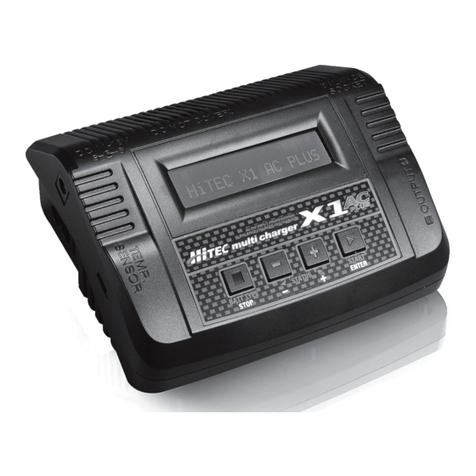
Hi-Tec
Hi-Tec X1 Touch User manual
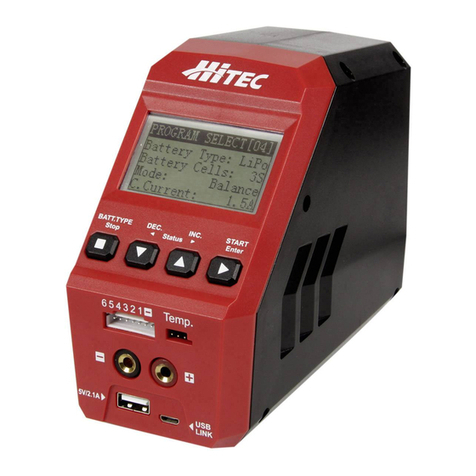
Hi-Tec
Hi-Tec X1RED User manual
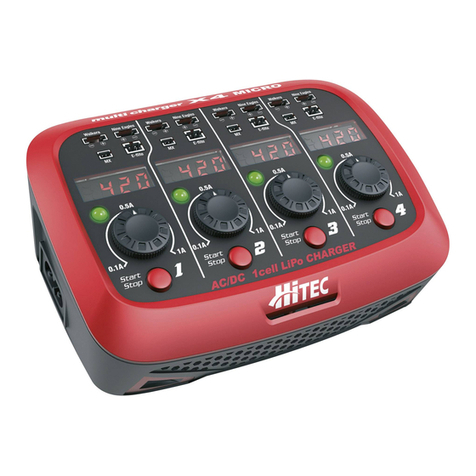
Hi-Tec
Hi-Tec X4 MICRO User manual
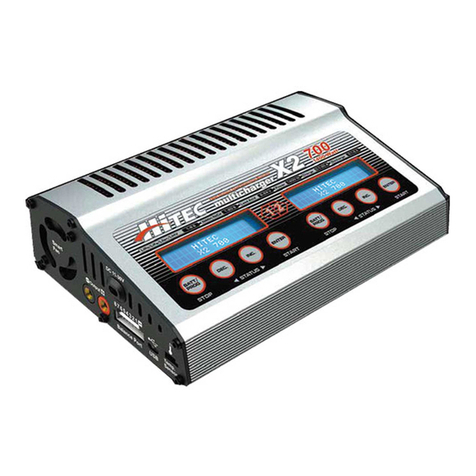
Hi-Tec
Hi-Tec X2-700 User manual
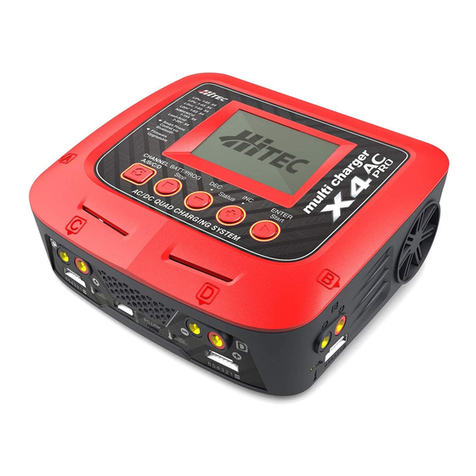
Hi-Tec
Hi-Tec X4 AC Pro User manual
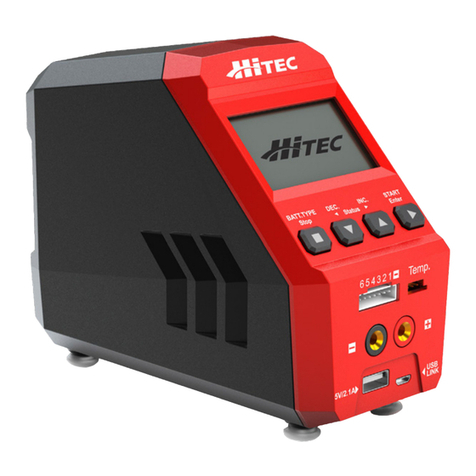
Hi-Tec
Hi-Tec RDX1 Mini User manual
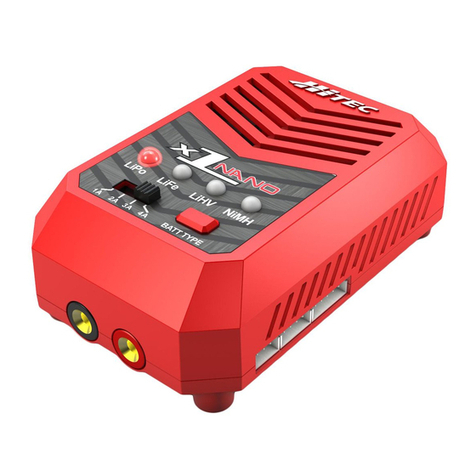
Hi-Tec
Hi-Tec X1 Nano User manual
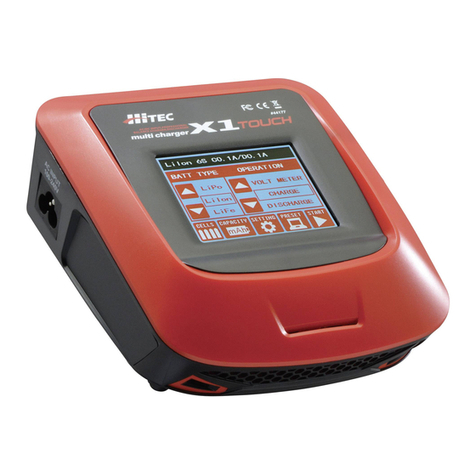
Hi-Tec
Hi-Tec X1 Touch User manual
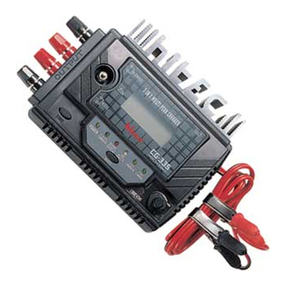
Hi-Tec
Hi-Tec CG-330 User manual
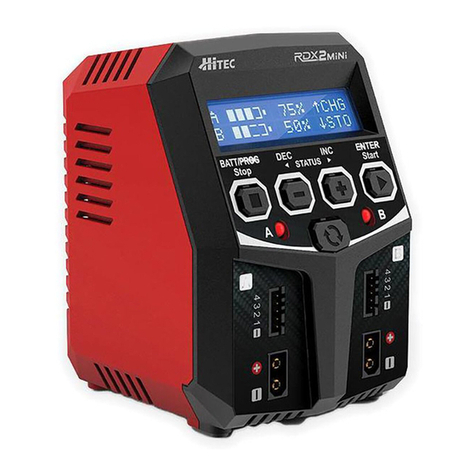
Hi-Tec
Hi-Tec RDX2 Mini User manual
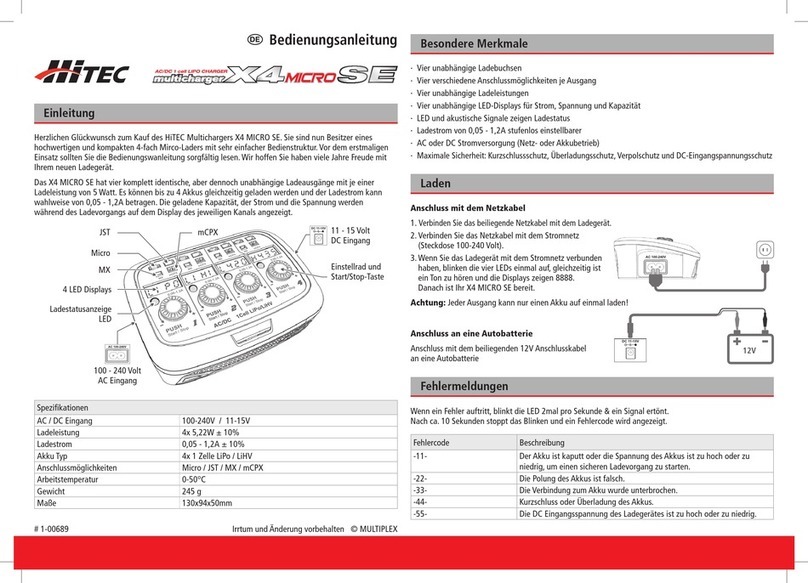
Hi-Tec
Hi-Tec X4 MICRO SE User manual
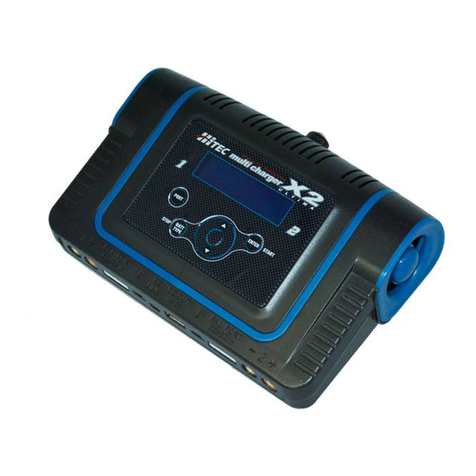
Hi-Tec
Hi-Tec X2 Ultima User manual
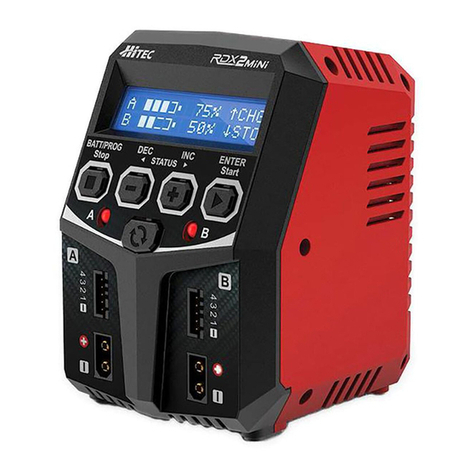
Hi-Tec
Hi-Tec RDX 2 MiNi User manual
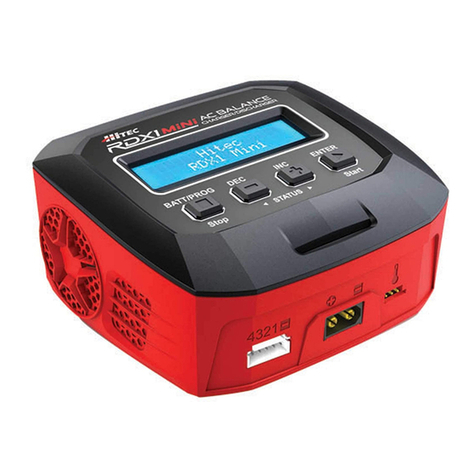
Hi-Tec
Hi-Tec RDX1 Mini User manual
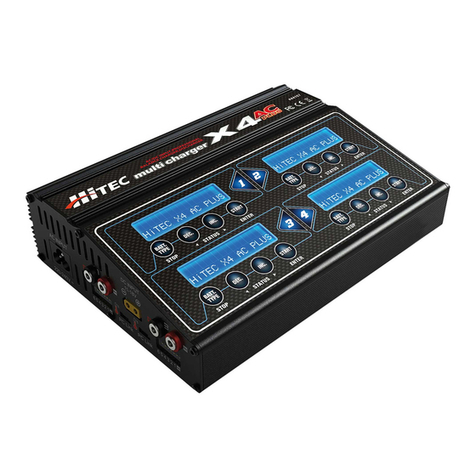
Hi-Tec
Hi-Tec X4AC PLUS User manual
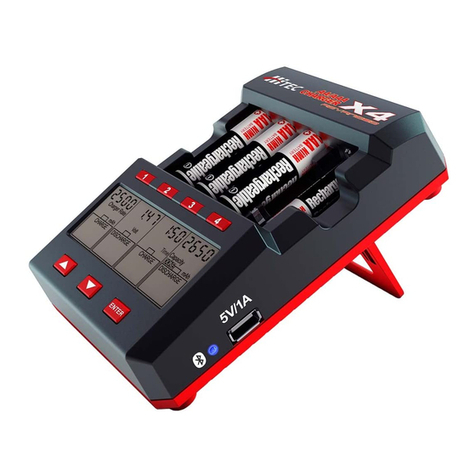
Hi-Tec
Hi-Tec X4 ADVANCED User manual

Hi-Tec
Hi-Tec RDX1 Mini User manual
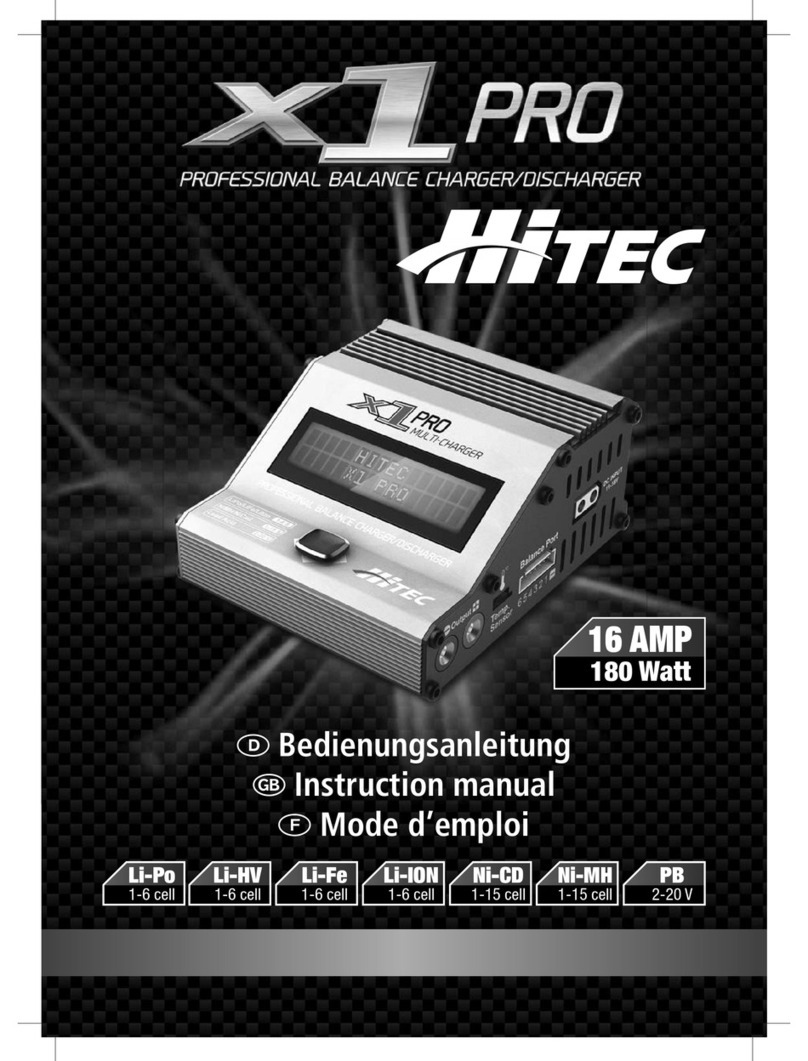
Hi-Tec
Hi-Tec X1 Pro User manual
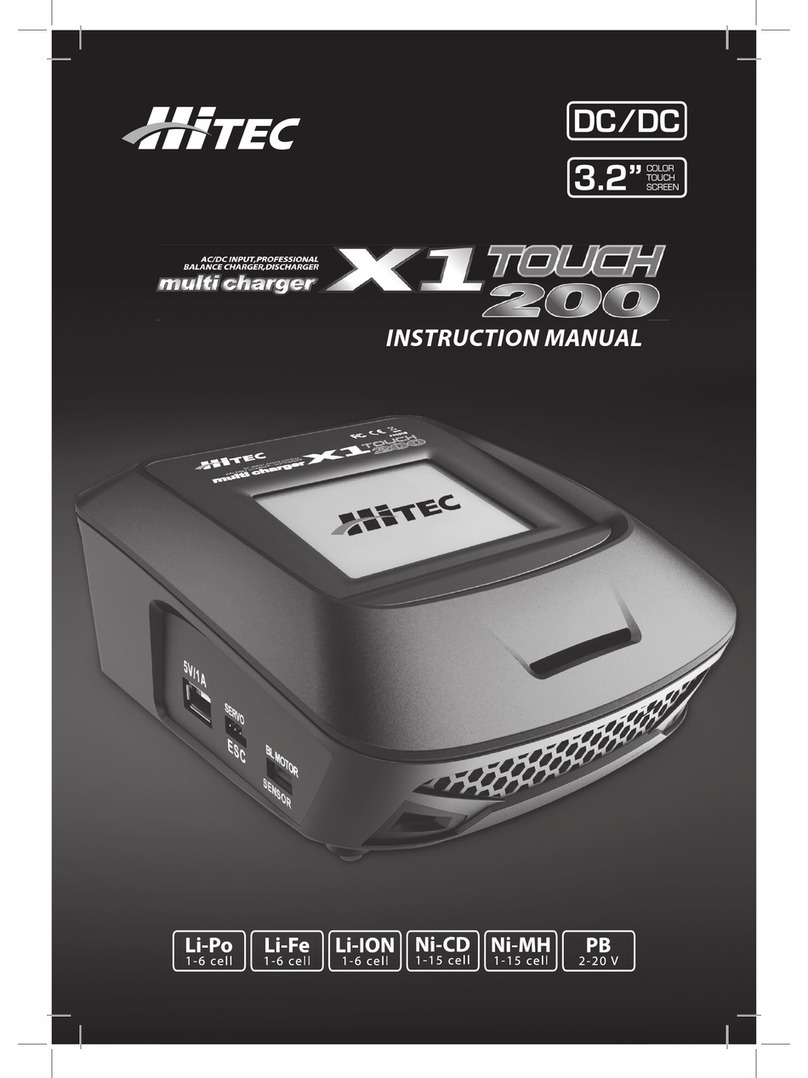
Hi-Tec
Hi-Tec X1-200 Touch User manual
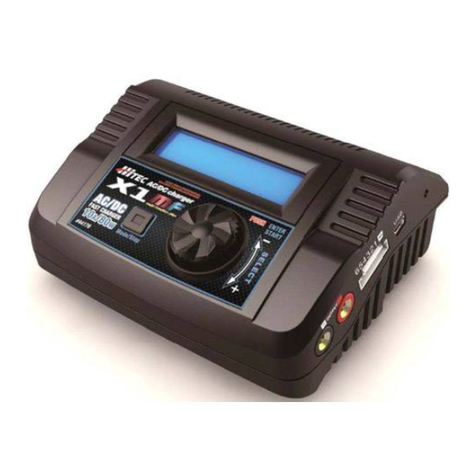
Hi-Tec
Hi-Tec X1MF User manual
